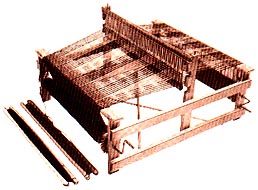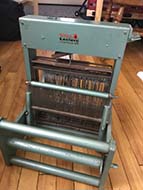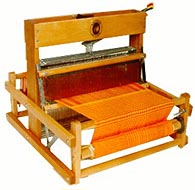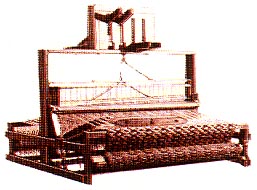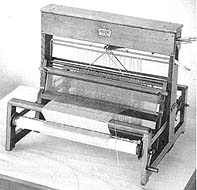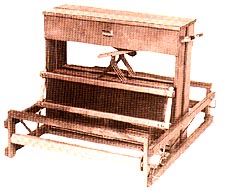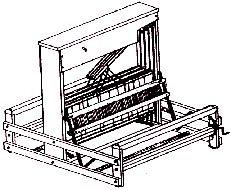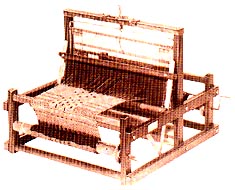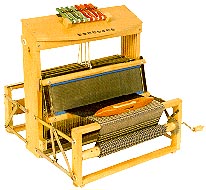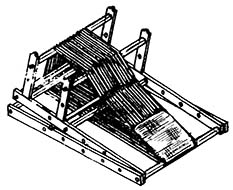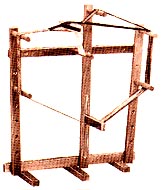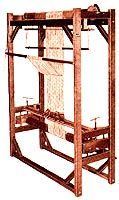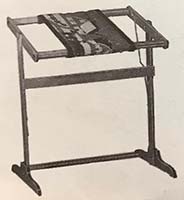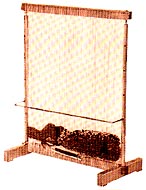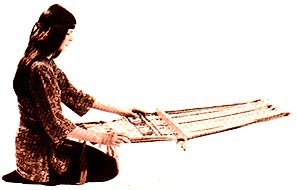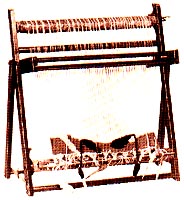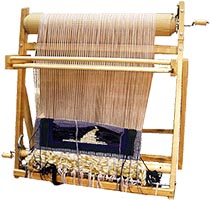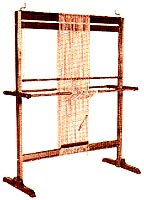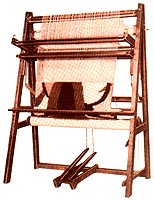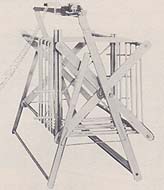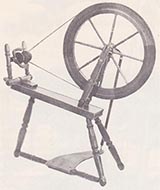Artisat
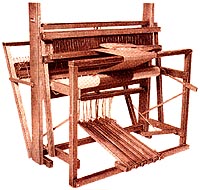
Status: Still in Production
Mechanisms: Jack and Countermarch (rare)
Shafts: 4, 8
Weaving Widths: 22", 24", 36"
Features: Both front & back beam fold for storage, Easily upgraded "4 shaft now, 4 shaft later" versions as well as a 8 shaft version with back hinge treadles and back beam stabilizer legs produced. Most Artisats have a 36" weaving width but for a short time a 22 inch version was also made.
Estimated Age: First appeared in 1968 as a 4 shaft loom with a built-in bench and the re-introduced without the bench in October 1969 as the "Artisat IV" without the bench. By 1976 it was just refered to as the "Artisat". The 22 inch version was made from October 1970 to mid 1976.
In 1973 Leclerc started using nylon jack supports, in the middle of 1974 Leclerc changed the shaft guides from vertical metal rods on each side of the castle as shaft guides to the current nylon pegs and in mid 1976 replaced the metal treadle brackets with wooden brackets. In 1982 an upgrade kit to turn a 4 shaft into an 8 shaft loom by attaching another 4 shaft castle was released.
Around 1984 Leclerc made a 24 inch version of the Artisat (4 and 8 shaft) using the wooden shaft frames produced for the Compact loom.
Sometime around 1997 we believe the 8 shaft version of the Artisat with the single piece castle side was released along with a Countermarch version that was discontinued in 2001 when a Back Hinge Treadle version was introduced.
Serial Number Prefixes: "A-"
Manual Download Page
Colonial
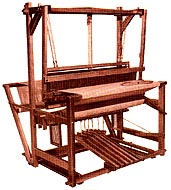
Status: Replaced with the Colonial I
Mechanisms: Jack or Counterbalance
Shafts: 4, 8
Weaving Widths: 45", 60"
Features: Beater can be set for Overhand or Underhand Operation, Frame held together with Wooden "keys", Back Beam folds for storage, easily convertible from Counterbalance to Jack and from 4 shaft to 8 shaft jack loom.
Estimated Age: Introduced in 1976 and made until 1980/1981 until it was replaced by the Colonial I (last model we have was dated Jan 1980). The Counterbalance configuration initially used a set of pulleys and two lower rollers with the pulleys being replaced with an upper roller as used in the Fanny and Mira looms.
Manual Download Page
Colonial I
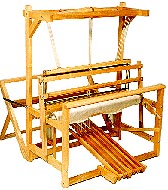
Status: Replaced with the Colonial v2
Mechanisms: Jack or Counterbalance
Shafts: 4, 8, 12
Weaving Widths: 36" (Computer-Dobby only), 45", 60"
Features: Beater can be set for Overhand or Underhand Operation, Colonial "keys" replaced with Bolts, Back Beam folds for storage, easily convertible from Counterbalance to Jack and from 4 shaft to 8 or 12 shaft jack loom, 12/16 shaft Mechanical (1986 to at about 1993) and Computer-Dobby (1998 to 2003) versions also produced. In 2002 Leclerc added a Back-Hinge Treadle option. Sometimes confused with older "Handicraft Shoppe" model
Estimated Age: Introduced in 1981 (first model we have was dated May 1981) and made until 2009 when replaced by the Colonial v2
Manual Download Page
Colonial v2
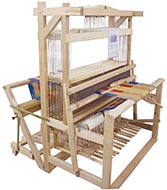
Status: Still in Production
Mechanisms: Jack
Shafts: 8, 12
Weaving Widths: 45", 60"
Features: Introduced in 2010, Leclerc redesigned the top of the castle with a pulley system to reduce treadling force, move the cables to the side out of the warp and improve the shed.
Estimated Age: Introduced in 2010.
Manual Download Page
Compact
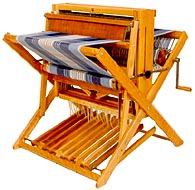
Status: Still in Production
Mechanisms: Jack
Shafts: 4, 8
Weaving Widths: 24"
Features: Loom folds up for easy storage, 4 shaft easily upgraded to 8.
Estimated Age: Introduced in 1985 this loom could be ordered with 4 or 8 shafts. Because the same castle was used for both configurations the 4 to 8 shaft upgrade was fairly inexpensive.
Manual Download Page
Diana

Status: Still in Production
Mechanisms: Jack
Shafts: 16
Weaving Widths: 24"
Features: Small Computer Dobby loom, originally known as the "Voyageur Computer Dobby" loom.
Estimated Age: Introduced as the Voyageur in 1999 and renamed as Diana in 2006.
Manual Download Page
Elite
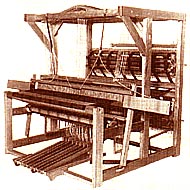
Status: No Longer Produced
Mechanisms: Jack, Counterbalance or Countermarch
Shafts: Up to 12
Weaving Widths: Unknown
Features: Billed as a "Professional handweaving loom for intensive production" it is believed to be more of a special order loom rather than a standard product.
Estimated Age: Shown in the late 1980's catalogs but not shown in the price lists.
Manual Download Page
F-Series
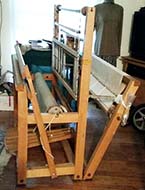
Status: Replaced with the Fanny
Mechanisms: Counterbalance
Shafts: 4
Weaving Widths: 27", 36", 45", 60"
Features:Back Beam folds in for storage. This early version of the Fanny was produced when Leclerc just used letters to designate their models. The "F" originally meant "folding" due to the fact that the loom was similar to the "M-Series" but with a folding back beam. Leclerc started calling this loom the "Fanny" sometime around 1957 soon after they replaced the ratchet brake and slip band on the warp beam with a friction brake.
Estimated Age: We believe this folding version of the "M" type loom was introduced in 1950-1951 and was renamed the "Fanny" in about 1957. See our Fanny Loom History and Counterbalance Design Changes for more information.
Manual Download Page
Fanny
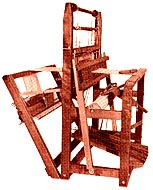
Status: Still Produced as a Special Order
Mechanisms: Counterbalance
Shafts: 4
Weaving Widths: 27", 36", 45", 60"
Features:Back Beam folds in for storage. Early versions were refered to as "Series F" looms before Leclerc started naming looms.
Estimated Age: We believe the folding version of the "M-Type" was introduced in 1951 but Leclerc started referring to the loom as the "Fanny" around 1957. In 1998-2000 Leclerc produced an Upgrade kit to transform a Fanny into a Nilus 8 shaft Countermarch (with front hinge treadles). See our Fanny Loom History and Counterbalance Design Changes for more information.
Manual Download Page
Fanny II
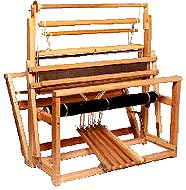
Status: Still in Production
Mechanisms: Counterbalance
Shafts: 4
Weaving Widths: 36", 45", 60"
Features: Shed Regulator included as standard, Back Beam folds in for storage.
Estimated Age: Introduced in the 2000 catalog. See our Fanny Loom History and Counterbalance Design Changes for more information..
Manual Download Page
Handcraft Shoppe (P Model)
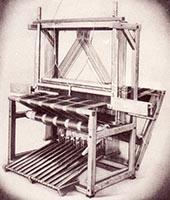
Status: No Longer Produced
Mechanisms: Jack
Shafts: 4, 8, 12
Weaving Widths: 45", 60"
Features: A predecessor to the Colonial, this loom uses bolts to hold the frame together and has cords that run down the side of the loom between the jacks and the lamms. Also called the "P Model" and sometimes confused with the Colonial I model.
Estimated Age: Early 1950's it was shown in the 1951 to 1955 but not in the 1949 or 1957 catalogs
Partial Assembly Manual
Inca
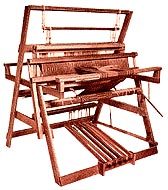
Status: No Longer Produced
Mechanisms: Counterbalance, Jack
Shafts: 4, 8
Weaving Widths: 36"
Features: A low cost loom shipped un-assembled and un-finished to make it more affordable. Leclerc also tried to market this loom under a separate name with it's own logo so the Nilus or Leclerc logo may not be on the loom but instead an "Inca" sticker may have been used.
Estimated Age: 4 Shaft Counterbalance introduced in 1980 with 4 Shaft Jack in 1981 and 8 shaft Jack in 1982. Discountinued sometime between 1994 and 1996.
Manual Download Page
Industrial Loom

Status: No Longer Produced
Mechanisms: Counterbalance, Jack
Shafts: 4
Weaving Widths: 60"
Features: Heavy duty version of the Mira also called the "Studio" loom. This was a special order loom that may or may not have ever been sold.
Estimated Age: Shown in the 1969 and the 1970 catalogs but with no prices.
Initiation
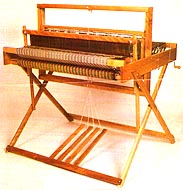
Status: No Longer Produced
Mechanisms: Jack
Shafts: 4
Weaving Widths: 32"
Features: Can be folded while warped for storage, height is adjustable.
Estimated Age: Introduced in 1982 and discontinued in 1985.
Manual Download Page
Kebec
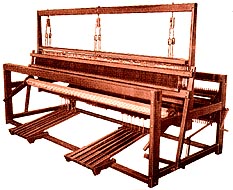
Status: Replaced with the Kebec II
Mechanisms: Counterbalance
Shafts: 4
Weaving Widths: 90", 100", 120"
Features: Two sets of treadle sets which can be attached to the front or rear of the loom, overhead pulleys support the shafts.
Estimated Age: Shown in catalogs from 1937 to 1949 as the "90 inch loom" which was just a wide version of the Mira in 1951 Leclerc started calling it the "Double Loom" and in 1952 introduced a folding version like the "Fanny". In 1957 a "Nilus" 4 shaft jack version was also available with an 8 shaft available as a special order. Between 1963 and 1966 catalog the 90 inch was replaced with a 100 inch loom called the "Kebec" with a similar frame to the Mira. In 1980 a back-hinge treadle option was released as well as a 120 inch version. In 1982 the Kebec was replaced with the "Kebec II".
Serial Number Prefixes: "M-"
Manual Download Page
Kebec II
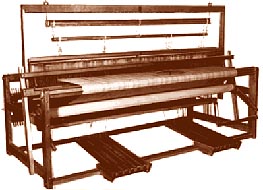
Status: Still in Production
Mechanisms: Counterbalance, Jack (rare)
Shafts: 4
Weaving Widths: 100", 120", 168"
Features: Treadle sets (2 provided) are always attached to the front, Breast Beams are heavy duty hexagonal or round wooden rollers, Pulleys on Kebec replaced with dual wooden rollers in Counterbalance version.
Estimated Age: Introduced in 1982 to replace the "Kebec" with a 100 and a 120 inch weaving width Jack (4 shaft) and Counterbalance versions. Between 1994 and 1997 the Jack version was discontinued. In 2001 a version with a weaving width of 168 inches was added.
Manual Download Page
L Model
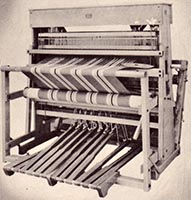
Status: No Longer Produced
Mechanisms: Jack
Shafts: 4, 8, 10, 12
Weaving Widths: 45"
Features: Similar Jack system as Multiple Shaft loom but Jacks are mounted overhead. Non-standard frame width and the front folds up for storage.
Estimated Age: Early 1950's it was shown in the 1949 to 1956 but not in the 1945 or 1957 catalogs.
Manual Download Page
Minerva
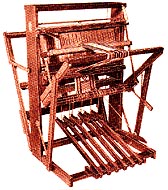
Status: No Longer Produced
Mechanisms: Jack
Shafts: 4, 8
Weaving Widths: 22"
Features: Front and Back Beams can be folded while warped for storage.
Estimated Age: Introduced in 1975 it was made until early 1984 when a 8 shaft converison kit for the Artisat was released. In 1982 Leclerc switched the design from short metal beater swords to longer wooden ones. Some of the first Minerva looms were sold without a wooden brace between to tops of the castle sides on the front and back.
Manual Download Page
M-Series
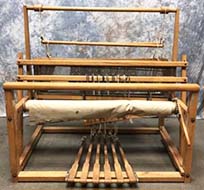
Status: Replaced by the Mira
Mechanisms: Counterbalance
Shafts: 4
Weaving Widths: 27", 36", 45", 60"
Features: Similar to the Fanny but without folding back beam. This early version of the Mira was produced when Leclerc just used letters to designate their models. Leclerc started calling this loom the "Mira" sometime around 1955 when they replaced the ratchet brake and slip band on the warp beam with a friction brake. See our Counterbalance Design Changes for more information.
Estimated Age: We believe the original was made in 1924 but Leclerc's oldest loom, appears in the 1937 catalog and all catalogs after that as either the "M-Series" or the "Mira" until it was discontinued in 1986 and later replaced by the Mira II in 2000.
Serial Number Prefixes: "M-"
Manual Download Page
Mira
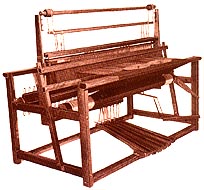
Status: Replaced by the Mira II
Mechanisms: Counterbalance
Shafts: 4
Weaving Widths: 27", 36", 45", 60"
Features: Similar to the Fanny but without folding back beam. Early versions were refered to as "Series M" looms before Leclerc started naming looms. Around 1955 Leclerc started referring to the loom as the "Mira" about the time the ratchet brake was replaced with a friction brake on the warp beam. See our Counterbalance Design Changes for more information.
Estimated Age: We believe the original was made in 1924 but Leclerc's oldest loom, appears in the 1937 catalog and all catalogs after that as either the "M-Series" or the "Mira" until it was discontinued in 1986 and later replaced by the Mira II in 2000. In 1998-2000 Leclerc produced an Upgrade kit to transform a Mira into a Nilus 8 shaft Countermarch (with front hinge treadles).
Serial Number Prefixes: "M-"
Manual Download Page
Mira II
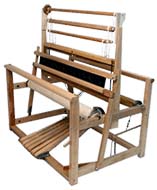
Status: Still in Production
Mechanisms: Counterbalance
Shafts: 4
Weaving Widths: 36", 45", 60"
Features: Similar to the Fanny II but without folding back beam. Shed Regulator included as standard.
Estimated Age: Introduced in the 2000 catalog.
Manual Download Page
Multiple Harness Nilus
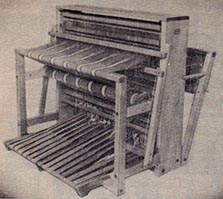
Status: No Longer Produced
Mechanisms: Jack
Shafts: 8, 12 (also 4 shaft)
Weaving Widths: 36", 45", 60"
Features: The predecessor to the Nilart, this loom had grooves in the inside of the wooden castle to guide the shafts and a cast iron jack system (see picture of mechanism here). On some versions there is a rectangular hole cut in the side of the castle.
Estimated Age: First appeared in the 1957 catalog as the "Multiple Harness Nilus" and then by 1966 was referred to as the "Nilart" for a short time. Between 1966 and the 1969 catalog, the cast iron jacks had been replaced with wooden version and the grooves for the shafts in the side of the castle had been replaced by metal rods making the loom what we normally refer to as the the Nilart. Many of the looms built before the "Nilart" name was used had a "Nilus" red sticker.
Nilart
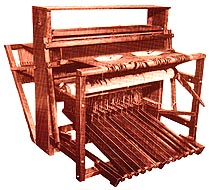
Status: No Longer Produced
Mechanisms: Jack, Countermarch (rare)
Shafts: 8, 12, 16 (60" only)
Weaving Widths: 36", 45", 60"
Features: Treadles can be attached to front of loom for 8 and 12 shaft, treadles can be attached to rear of loom for 12 and 16 shaft, back beam folds for storage, 8 to 12 and 12 to 16 shaft upgrades and jack to Countermarch conversion kits were available, Computer-Dobby 12 and 16 shaft versions (in both 45" or 60") produced.
Estimated Age: Version with wooden jacks first appeared between 1962 and 1966 in 8 or 12 versions both with a 12 shaft castle and in 36, 45 and 60 inch weaving widths. In 1971 the 36 inch was discontinued leaving just the 45 and 60 inch versions.
In 1973 we believe Leclerc added nylon Jack Supports to the ends of the Jacks for the shafts to sit on as well as using a "L" shaped jack design.
In 1975 Leclerc changed from using vertical metal rods on each side of the castle as shaft guides to the current nylon pegs (see pictures here).
In 1980 a slightly deeper version with 16 harnesses and Back-Hinge Treadles was introduced as well as a Back-Hinged Treadle option for the 8/12 shaft version. A Countermarch conversion kit was announced in 1997 and a Computer Dobby version of the 16 shaft in 1999. In 2000 all versions of the Nilart except for the Computer Dobby were discontinued. In 2004 with the introduction of the Weavebird, all Computer Dobby looms including the Nilart were discontinued.
Serial Number Prefixes: "N-"
Manual Download Page
Nilus (early design)
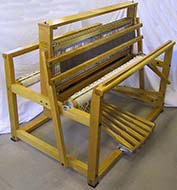
Status: Replaced with the Nilus (without grooves in castle)
Mechanisms: Jack
Shafts: 4, 8
Weaving Widths: 27", 36", 45", 60", 90"
Features: This early version of the Nilus used shafts with metal loops in each of the four corners that slide in grooves in the castle like the "Multi-Harness Nilus model". The first version also used a system of cast iron metal levers under and attached to the shafts similar to the "Multiple Harness Nilus". (see picture of shafts and the lever mechanism here). By 1958 Leclerc had replaced the metal levers with wooden jacks and lamms but the jacks were still attached to the shafts on the right and left side using a short metal bar (see picture here). This is unlike the current version of the Nilus where the shafts rest on the outer end of the jacks.
The initial version of this loom did not have a folding back beam but later versions did. The jack mechanism was also available as a kit to convert "M-Series" counterbalance looms to this new Jack mechanism.
Estimated Age: First appeared in the 1955 catalog (but not 1952) as the first Leclerc Jack loom with a fixed back beam like the Mira. By 1957 it was shown with a folding back beam. By 1965 the design was changed to the current Nilus design with wooden jacks and the current shaft design without the loops. Vertical metal bars on each side of the castle acted as guides for the shafts.
Serial Number Prefixes: "N-", "NC-"
Nilus
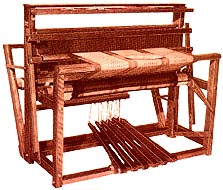
Status: Still in Production
Mechanisms: Jack
Shafts: 4, 8
Weaving Widths: 27", 36", 45", 60"
Features: Unlike the early "metal" Nilus the back beam folds in for storage. Ability to buy as a 4 shaft and add 4 more shafts later, 8 shaft version with back hinge treadles is available. This. Note that because the company name was "Nilus" many Leclerc looms are incorrectly referred to as "Nilus" models because of the company name on the side.
Estimated Age: By 1965 the Nilus design was changed to wooden jacks like the current design and vertical metal rods were added to each side of the castle to guide the shafts instead of the grooves.
In 1973 Leclerc added nylon Jack Supports to the ends of the Jacks for the shafts to sit on.
In mid 1974 Leclerc changed from using vertical metal rods on each side of the castle as shaft guides to the current nylon pegs (see pictures here).
In 1982 an upgrade kit to turn a 4 shaft into an 8 shaft loom by attaching another 4 shaft castle was released. Also, sometime in 1986/1987 the Nilus was removed from the catalog but re-appeared in 1997 in 4 and 8 shaft versions with the single castle unit that is available today. In 1998-2000 Leclerc produced an Upgrade kit to transform a Nilus, Fanny or Mira into a Nilus 8 shaft Countermarch (with front hinge treadles).
Serial Number Prefixes: "N-"
Manual Download Page
Nilus II
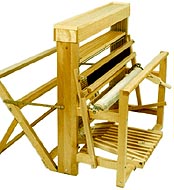
Status: Still in Production
Mechanisms: Jack, Counterbalance or Countermarch
Shafts: 4, 8
Weaving Widths: 36", 45", 60", 72"
Features:Folding back beam with stabilizer feet, convertible between Counterbalance, Jack and Countermarch, "4 Shaft Now, 4 Later" version can be easily upgraded to 8 shafts, Counterbalance version has integral shed regulator, optional versions of the jack loom are available with back hinge treadles.
Estimated Age: First appeared in the 1985 Price List with 4 shaft Jack and Counterbalance versions plus a the "4+4" kit to Upgrade the Jack to 8 shafts. A Countermarch version was introduced in 1997.
Manual Download Page
Therapeutic Nilus
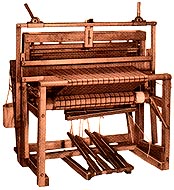
Status: No Longer Produced
Mechanisms: Jack
Shafts: Unknown
Weaving Widths: Unknown
Features: Modified Nilus Loom with adjustable tension settings to allow the loom to be used for rehabilitation purposes, loom allows graded resistance in elbow, wrist, plantar and shoulder movements and the base has been adjusted to fit a wheelchair.
Treadle Stands
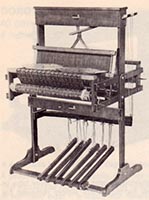
Status: Dorothy, Meco and Medico Treadle Stands still Available
Mechanisms: Jack
Shafts: 4 or 8
Weaving Widths: 15", 15 3/4", 22", 24"
Features: A number of the Table Looms could be ordered with Treadle Stands that turned them into floor looms. This included the Jano, Meco, Medico and currently the Dorothy models. See Table Loom section below for more information on these looms.
Weavebird
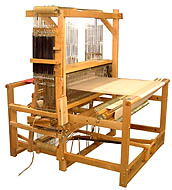
Status: Replaced by the Weavebird v2
Mechanisms: Countermarch
Shafts: 16, 24 or 32
Weaving Widths: 27", 36", 45", 60"
Features: A Computer-Dobby Loom that uses counterweights to deliver effortless treadling regardless of the shafts being selected.
Estimated Age: Introduced in 2002 as a 16 shaft, the 24 shaft was added in 2004 and the 36 shaft in 2008.
Manual Download Page
Weavebird v2
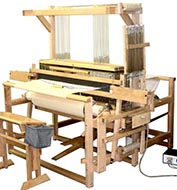
Status: Still in Production
Mechanisms: Countermarch
Shafts: 16, 24 or 32
Weaving Widths: 27", 36", 45", 60"
Features: A number of enhancements to the Computer-Dobby Loom to reduce adjustment and make treadling easier.
Estimated Age: Introduced in 2010.
Manual Download Page
